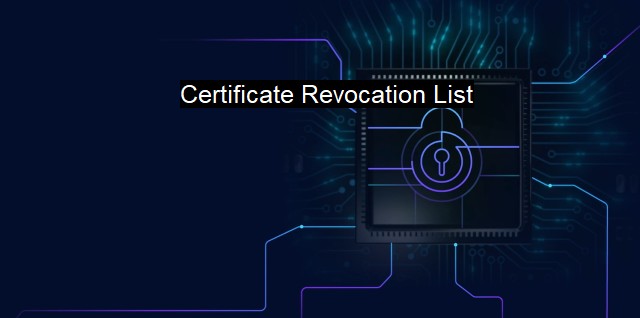What is Certificate Revocation List?
Utilizing the Power of Certificate Revocation Lists (CRLs) in Cybersecurity: What They Are, How They Work, and Why They are Necessary
A Certificate Revocation List (CRL) is a crucial concept in the area of cybersecurity and antivirus protection. It enhances the security of a given system or network by forming the heart of the Certificate Revocation system, affecting the overall integrity of the system through impacting the efficacy of the cryptographic security employed. CRLs play into the wider realm of Public Key Infrastructure (PKI) and encryption, both of which are key systems of defense in today's digital world.To broadly understand how the Certificate Revocation List functions, one must first understand what a digital certificate is in the world of cybersecurity. Digital certificates, essentially virtual passports, allow entities (like users, computers, or organizations) on the internet to verify each other's identities, establishing a basic level of trust. These certificates are issued by Certificate Authorities (CAs), whose responsibilities include validating the identities of those it provides with digital certificates.
A Certificate Revocation List is a document that Certificate Authorities generate and distribute, containing a list of their digital certificates which are no longer valid or trusted. The key reason for the loss of trust is called certificate revocation. The latter translates to the situation when the private key related to the certificate has been compromised, which can happen when the user loses control over the cryptographic key.
The fact that a breach or loss of the cryptographic key invalidates the safe groundwork of network-based interactions raises the need for the CRL. When the safety of a certificate is in doubt, a Certificate Revocation List provides a way by which systems can validate whether a presented certificate is still reliable. If the certificate appears on the CRL, it is deemed untrustworthy, and the system won't permit any actions that rely upon that certificate.
The Certificate Revocation List needs regular updating by Certificate Authorities to ensure the latest status of certificates is accurate and accessible by entities that rely on a given CA's issued certificates. Subsequently, the regularly updated list aids in enhancing security by decreasing the potential for unauthorized actions by individuals or groups wielding revoked certificates. Any system or software dealing with certificates, such as antivirus software, must check them against the CRL to block possibly untrustworthy certificates and notify the system admins.
From an antivirus and cybersecurity perspective, incorporating regular checks against the CRL is integral to maintaining system protection. Given that one of the main ways harmful software can infiltrate a system is by appearing trustworthy (by presenting a genuine-looking - but compromised - certificate), the ability to verify the legitimacy of a certificate is an important tool for an antivirus software. In addition to protecting against untrustworthy certificates, the process provides another layer of defense against a variety of attack types, such as Man-in-the-Middle or Phishing attacks.
Some critics suggest that CRLs can cause a delay in communication processes because systems will need to contact the CA and get the current CRL before proceeding. To address this issue, newer methods such as the Online Certificate Status Protocol (OCSP) have been developed, which allow immediate checks on individual certificates, thereby maintaining system efficiency.
The CRL retains its importance as a system for ensuring certificates' trustworthiness and continuing to guarantee safety amidst the escalating cybersecurity threats. More than a one-size-fits-all strategy, cybersecurity and antivirus protection require a multi-layered approach - and the inclusion of systems like CRLs is an essential part of that mix.
Understanding the operation and significance of the Certificate Revocation List is critical in the ever-evolving field of cybersecurity. It offers an effective level of security in contexts where certificates' authenticity is key and provides a significant defensive measure in the protuberant war against cyber threats.

Certificate Revocation List FAQs
What is a certificate revocation list (CRL) in cybersecurity?
In cybersecurity, a certificate revocation list (CRL) is a document that lists digital certificates that have been revoked by the issuing certificate authority (CA) before their scheduled expiration date.Why do we need certificate revocation lists (CRLs) in antivirus software?
Antivirus software uses certificate revocation lists (CRLs) to identify and block malicious software and connections that are using revoked digital certificates. This helps to ensure the security of the system and prevent potential cyber attacks.How often are certificate revocation lists (CRLs) updated in cybersecurity?
Certificate revocation lists (CRLs) are typically updated every few hours or days, depending on the level of security required by the organization. Some CAs also offer real-time or near real-time updates for high-security environments.What is the difference between a certificate revocation list (CRL) and an Online Certificate Status Protocol (OCSP) in cybersecurity?
In cybersecurity, a certificate revocation list (CRL) is a document that lists digital certificates that have been revoked by the issuing certificate authority, whereas an Online Certificate Status Protocol (OCSP) is a real-time query and response protocol that provides the status of a single certificate at the time of the request. CRLs are updated periodically, whereas OCSP responses are issued in real-time as needed.| | A | | | B | | | C | | | D | | | E | | | F | | | G | | | H | | | I | | | J | | | K | | | L | | | M | |
| | N | | | O | | | P | | | Q | | | R | | | S | | | T | | | U | | | V | | | W | | | X | | | Y | | | Z | |
| | 1 | | | 2 | | | 3 | | | 4 | | | 7 | | | 8 | | |||||||